|
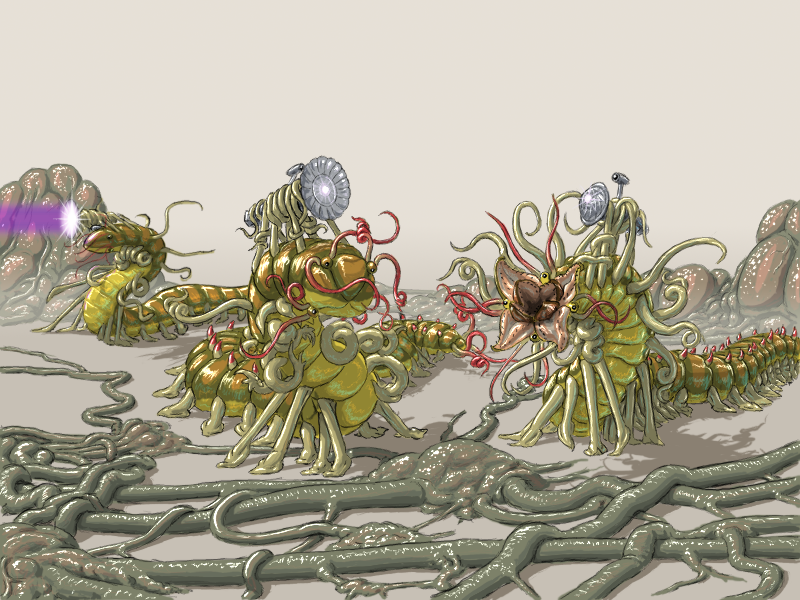
Description
The Squirm are bizarre polymorphic super-organisms that would be of great scientific interest if not for the fact that they are xenocidal berserkers that relentlessly eradicate any other sapient life they encounter.
The basis of a squirm super-organism is the "blight," an extended region of interconnected organoids overgrown with ropes and tubes that criss-cross the area and join the organoids together.
The branching tubes and tendrils act as roots, shoots, stalks, and vessels to collect water and nutrients, distribute it to the rest of the colony and associated mobiles; and/or to act as structural support.
Unlike plants and fungi, to which the blight somewhat resembles and is often compared, the tubes and tendrils retain some amount of mobility.
A blight will grow large numbers of zooids – individual animals that together form a colonial mass – and join them together like biological legos.
The resulting pieced together collective organisms are composed of consecutive ring segments sprouting various types of tentacle, making up a variety of worm-like body shapes called "mobiles."
A single colony "individual" may appear as a serpentine tube, a spaghetti-like mass of writhing tendrils, a worm with several or many limbs (such as tentacles or parapodia) branching from it, or compact blobs that extend filaments to nearby control points of machinery. They frequently have clusters of sensory organs sprouting from their body, generally near major nerve nodes.
Common limb designs are simple whip-like tentacles, tentacles that have hooks or claws, tentacles with suckers, tentacles with expanded tips that may sprout sub-tentacles for fine manipulation, and parapodia (thicker foot-like, leg-like, or fin-like limbs for locomotion).
It is thought that Squirm are not naturally evolved. They seem to engineer themselves for various purposes, and new varieties are often encountered.
The Squirm collectives are not always entirely biological – they often incorporate machines into their design.
The meat-machine interface is usually via biological cables or filaments.
Mobiles will often integrate weapons, defenses, or sensors into their bodies; or will serve as the "brain" of vehicles or robots.
Blights will often host factories, reactors, or other stationary facilities.
Growing blights are as much of an element of a Squirm invasion as the mobile soldiers.
They attack the ecosystem, overgrowing fertile fields and denying agriculture and other land-based resources to their enemies.
In an invasion, blights can pop up anywhere – growing like mold in dank basements, overtaking vacant lots, maturing in sewers or ventilation systems or access tunnels.
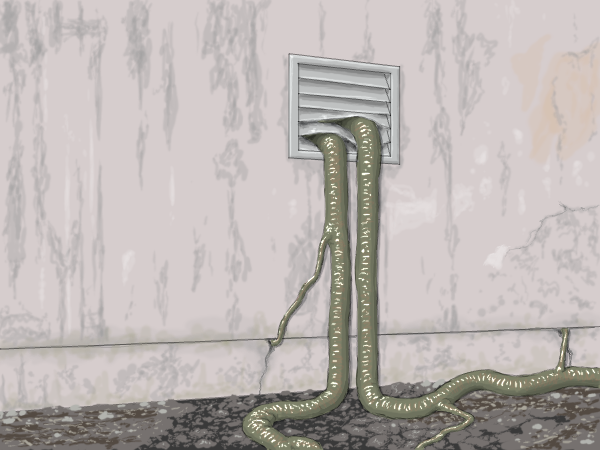
Internal Anatomy
A typical "primitive" zooid is a muscular tube or ring with a simple nervous system, a basic gut and excretory system, a set of counter-current flow lungs, a closed circulatory system with several hearts, and rudimentary sensory abilities.
However, there are many different varieties of zooid – some have eyes or other sensors, others are mostly muscle, or may consist mainly of stiff structural rods, and still others are used to build integument or for digestion or communication and coordination within the colony.
Zooids have a four-fold radial symmetry. The Squirm mobiles usually retain some remnant of this four-fold symmetry.
Squirm zooids communicate with each other via fibers that act like fiber-optic cables, carrying short-wave infrared light pulses that convey information.
Command and control of the colony is usually carried out by a cluster of ganglion zooids, linked together by many bio-optical cables to coordinate the colony's movements.
This reliance on light for intra-colony communication makes Squirm sensitive to laser weapons, which overwhelm the communications channels with their intense light and stun the squirm.
Other than their sensitivity to light-based attacks, the modular nature of Squirm colonies makes them very resilient to damage.
The redundant organs mean there is no single point of failure; connections to badly damaged zooids can be shut down (to prevent hemorrhage, for example, or keep sepsis from poisoning the entire colony); killed or non-functional zooids can be jettisoned; and repairs can easily be made by attaching new zooids.
The main vulnerability of mobiles is the main ganglion cluster, that acts like a brain. If this is destroyed, the mobile is left without coordination, communication, senses, or the ability to think complex or abstract thoughts.
Senses
Analysis of deceased specimens suggests that Squirm vision is sensitive to short-wave and near infrared light and most of the visible spectrum. Their hearing is likely to be good, although not quite as acute as that of a Human at higher frequencies. The high concentration of nerves in their tentacles likely indicates a well developed sense of touch and taste.
Communication
No one has observed Squirm using any kind of vocal communication. Laser detector and locator sensors have observed Squirm emitting flashes of short-wave infrared light. It is theorized they use these flashes to talk to one another.
Blocking short-wave infrared light (such as with dense smoke or fog) seems to prevent complex forms of Squirm communication.
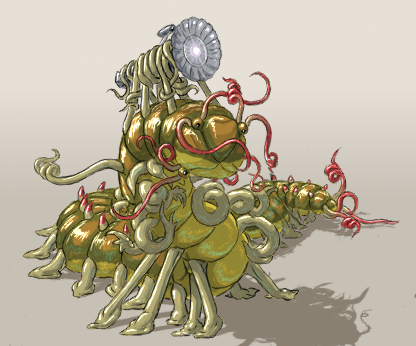
Locomotion and Biomechanics
Squirms move using muscular hydrostats, giving them both strength and flexibility. Longitudinal muscles contract to shorten a Squirm body part, circumferential muscles squeeze the longitudinal muscles to lengthen them, and helical muscles can apply twisting torsion. Bending is accomplished by contracting the longitudinal muscles on one side but not the other.
Where needed, Squirm will incorporate rods of stiff elastic tissue into their bodies, which gives structural support and aids in holding them up against gravity or transmitting forces via leverage but impedes their flexibility.
Those designs with fewer of these rods can squeeze through remarkably tight spaces; for better cross-country mobility more rods are needed for longer, stronger, more effective limbs and torsos that can transmit locomotor forces to these limbs.
Many Squirm designs use gecko-like sticky pads that let them climb up walls and across ceilings and grip with surprising tenacity.
Diet and Feeding Habits
A blight will harvest resources from the surrounding landscape and uses it to grow itself or more zooids to assemble into mobile armies.
Squirm blights are generally denuded of any other life form, although there is often a transition zone where the blight is still growing into and overcoming the native vegetation.
Once local food sources are exhausted, they typically sprout leaf-like panels to capture sunlight for energy and carbon dioxide for feedstock to synthesize more Squirm.
Squirm mobiles appear to be able to eat most normal food materials – meats, grains, nuts, non-woody vegetation, and the like – as long as it is fairly bland.
Their digestive systems are fairly simple and they cannot get much nutrition out of coarse or woody material, nor can they handle much in the way of biological toxins, even those than can easily be digested by humans (such as the chemicals in onions, garlic, coffee, chocolate, grapes, and most spices).
A Squirm blight can decompose and digest nearly anything organic, and can in turn produce a nutrient rich fluid that it will feed to its mobiles.
Consequently, the mobiles will commonly collect suitable material and bring it back to their blight for processing.
When on the march, squirm mobiles will carry a solidified version of this liquid with them as field rations.
Squirm are not in any way adverse to eating sapient beings. Many that they kill are brought back to their blight to be digested and either turned into new zooids or fed to the mobiles.
Reproduction
Blights emit spores that will sprout into new zooids, which can grow into new mobiles that will then spread and grow into new blights.
The spores need a suitable environment in which to germinate.
Unfortunately, inside of an animal is an ideal environment for this.
The new zooids become parasites, infecting their host and reproducing inside of it.
Under normal circumstances, they simply consume their host from the inside, eating the less-vital parts first so that their host stays fresh for as long as possible.
However, a Squirm infection can be far more insidious.
They can grow into filaments that insinuate into the nervous system, affecting their host's behavior.
The host can gain alien compulsions aiding the Squirm's agenda, or experience unexplained memory lapses in which the host was apparently under the infection's control.
Eventually, the host has its own nervous system entirely eaten away and becomes a zombie-like husk controlled by the squirm filaments from a central mass within the central body.
At this point, the other body organs may begin to be replaced by zooids, until the former host is simply an envelope of skin over a mass of squirming zooid worms and the remains of its skeleton.
These Squirm zombies are used to infiltrate the communities of their target population, either gathering information, infecting others, or spreading new blights.
There is some evidence that once a host is consumed by a Squirm infection, the remaining parasitoid mass retains at least some memories of the previous host.
The resulting blight that might develop from the matured parasitoids is also believed to retain some of it's hosts mind.
Human and Gummi medicine has developed many techniques for curing a Squirm infection.
Unfortunately, the Squirm rapidly adapt and each new invasion is likely to introduce new strains of Squirm that are resistant to the previous medicines.
In this way, a Squirm attack is a crisis not only of a military nature but of the public health system, and the civil government has to deal with a simultaneous invasion and pandemic.
Psychology
Squirm are implacable, relentless, merciless killers. They seem to be made only for invasion and destruction. All interactions of Squirm with other sapient species have been violent. If Squirm have a softer side that they show to other Squirm, no one knows about it.
Individual Squirm mobiles do not appear to have much self-determination, although they can display clever tactical behavior. Some mobiles will take the role of officers, commanding groups of combat mobiles to achieve an objective, or coordinating multiple such groups to support a greater strategic vision. When these individuals are neutralized, the remaining Squirm become less oriented on their objective and instead tend to focus on destruction or retreat to safety.
It is thought that the blights have a higher-level of intelligence, capable of envisioning larger and more complex goals and of devising complex and intelligent methods to implement them.
As far as can be determined, all blights tend to cooperate in the greater goal of overrunning worlds and eradicating the sapient species on them.
Different blights have differing personalities. One may prefer to operate by stealth and infection, slowly subsuming a population from within; while another may prefer a more straightforward approach of a sudden attack that wipes out the opposition.
One may make hordes of poorly equipped mobiles that attack en mass to saturate an enemy's defenses; another may concentrate more on a smaller number of high quality and well-equipped units.
In this way, blights can specialize to divide up a problem toward their individual strengths.
Squirm never surrender. Even if hopelessly outnumbered and outgunned if they cannot retreat they will continue to throw themselves at their enemies in suicidal charges. If a squirm is stunned, grappled, sedated, or otherwise restrained, they will not tolerate this condition as long as they are conscious and able to act. They struggle ceaselessly until dying from exhaustion or battering themselves to death against their restraints or prison walls.
Society
All that is known of Squirm society is of their military. No civilians have ever been encountered. Even their means of production are run as a military operation. When the Gummis overran the Squirm strongholds of Sextans A, they found no evidence at all that Squirm ever even had a civilian society. They appeared to be a species totally focused on military conquest and extermination.
So what are the Squirm? Where do they come from? How did they arise in many different galaxies simultaneously? No one knows. Lots of people have ideas, some of them more sane than others.
- A biological warfare agent designed by the Antecessors. In order to keep other sapients from finding their secret pinnacle of power, they engineered a berserker to eliminate any other space-going species.
- The Antecessors themselves, again jealous of their secrets and motivated to destroy other species with interstellar reach.
- The things that destroyed the Antecessors. Maybe there was a war across the galaxies that the Squirm eventually won, but this one encounter with another space-going species left them so paranoid that they reflexively attack anyone else.
- A species that evolved well after the Antecessors dissapeared, who nevertheless believe that all other space-going sapients are an existential threat and thus act to wipe them out before they are themselves destroyed. Do unto others before they do unto you.
- Radical environmentalists. Having reached a level of science and physical understanding more advanced than ours, they realized that wormhole networks – and multiply connected topologies of space-time in general – were a threat to the integrity of space-time itself. If left to propagate without control, the very fabric of existence of our universe would unravel!
- They have a web of wormholes that spans the Local Group. They worked hard on this network to get it all synchronized and stable, and get very cranky when other sapients show up with their own wormholes and knock things out of whack with their causality loops.
- A conspiracy. There are no Squirm. They are made up by the secret masters of the Verge to spread fear and ensure their control over the populace. Put on your tin-foil hats!
One possible clue comes from re-contacted colonies of the Verge lost during The Bump in the Night. Although worlds connected to the Verge network have been attacked by the Squirm, none of these isolated worlds recorded anything similar. It is entirely possible that Squirm only carry a grudge against interplanetary civilizations in general or wormholes specifically, and anyone not using wormholes will not be threatened by them.
Squirm Package |
These are the traits common to all Squirm. They will be further modified by the Type for a given design.
| | Starting AttributesSub-Attributes- Biting Brawn +2
- Fearless +4
- Toughness +4
Abilities- Extra Hands
- Gripper +2
- Heartless +2
- Lungless
- Natural Weaponry: Cutting Teeth
- Repairable
- Senses: Discriminatory Scent
- Senses: Feelers
- Senses: Night Vision +2
- Senses: Wide Angle Vision +2
- Senses: Vibration Sense (all)
- Squishy
- Stretchy +2
Limitations- Neurological Limitation — Maybe? Anempathic or Non-Self-Aware are possible. Anepisodic, Anexperiential, Anumeric, Asymbolic, Asyntactic, and Non-Sapient are already ruled out by the data
- Personality Traits — Probably many, enough to turn them into fanatical remorseless killing machines
- Depleting Damage (lasers)
- Soft
Social Standing- Discrimination +5
- Non-person 2
Skills- Speak Squirm +1
- Evade +0
- Fight +0
- Grapple +0
- Profession (soldier) +2
- Recon +0
- Sneak +0
- Spot +0
- Shoot +0
- Use Gear +0
|
Squirm Mobile Morphotypes
Squirm mobiles are made, not grown. Consequently, they come in a large variety of shapes, with an equally large variety of capabilities.
However, some models are more common than others.
A number of frequently encountered squirm varieties, or morphotypes, are given below.
These can be modified and customized by the referee to increase the diversity of encountered squirm and to thee the players on their toes.
Squirm Wiggler |
Wigglers are the most commonly encountered Squirm mobiles. They are the cheapest to produce, and are often employed in large numbers. Some blights barely equip their wigglers, sending them in massive waves to overwhelm their victims. Others produce fewer but equip them better, with high-end disintegrator rays, deflectors, and other gear.
The listed Wiggler is Size +0, but they have been encountered in a wide range of sizes – from Size -4 (ferret sized) to Size +2 (horse size). Blights will make the wigglers to the Size needed for a particular role or job.
| | 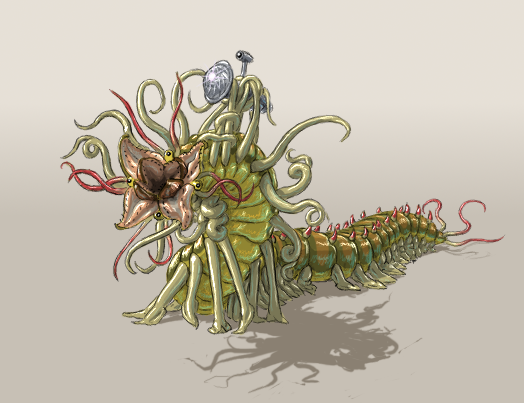
Starting AttributesSub-AttributesAbilities- Environmental Movement: Climber +3
- Environmental Movement: Swimmer +2
- Environmental Movement: Sticky
- Environmental Movement: Soft Ground, Slippery Ground, Uneven Ground, Tangled Ground +2
- Squirm Package
- Stretchy +1
- Ground Fighter
Limitations- Physical Handicap: Poor Runner +2
|
| Unarmed Penetration: 2d6, -7 RS
Unarmed Wound Score: +2
Unarmed Control: 2d6, -2 RS
Penetration Limit: 2d6, +0 RS
| Large Wound Limit: +7 | Wound Score Limit: +10¼ |
Injury Susceptibility: +0
| Action Score: +0 | Action Points: 5 |
| Stamina: 10 | Perseverence: 40 |
| Base Move: 5 m/turn | Maneuver: 30 m/turn² |
Top Ground Speed: 10 m/turn, 12 km/h
Top Swim Speed: 5 m/turn
Top Climb Speed: 7 m/turn
Long Jump: 1.7 m standing, 2.5 m running
High Jump: 1.4 m cleared, 3.4 m reach
Thresholds | | Penalty | Fatigue | Drain | Control | Encumbr. | | -1 | 3 | 10 | 3 | 15 | | -2 | 4 | 15 | 4 | 20 | | -3 | 5 | 20 | 5 | 30 | | -4 | 7 | 30 | 7 | 40 | | -5 | 10 | 40 | 10 | 50 | | -6 | 15 | 50 | 15 | 70 | | -7 | | | 20 | 100 |
|
Attacks| Description | Type | Pen | Wound | AP | Sharp | Blunt | Def | Length | Grip | | Slap/Smash | Smash | 2d6, -7½ RS | +2 | +0 | +0 | +2 | +0 | 3 | +2 | | Bite | Slash | 2d6, -5 RS | +3 | +0 | +2 | +2 | +0 | 3 | +2 |
|
Squirm Runner |
Runners are builds useful for mobility over open ground. Although less versatile than wigglers across a variety of terrain types, they offer speed on unobstructed terrain. Runners are relatively more resource intensive to produce than wigglers; consequently they also tend to be better equipped. Runners have been observed ranging from between Size -3 (house cat) to Size +2 (horse); the example below is Size +0.
| | 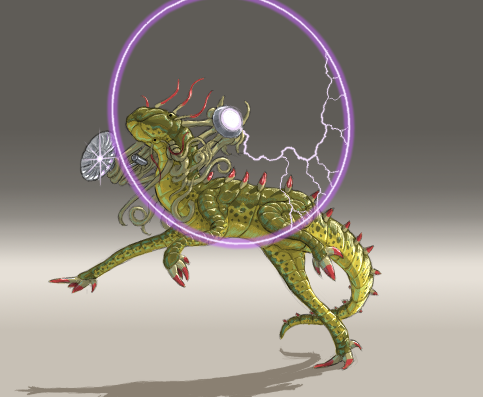
Starting AttributesSub-Attributes- Agile +2
- Lower Body Brawn +2
Abilities- Increased Speed (Ground) +4
- Squirm Package
Skills |
| Unarmed Penetration: 2d6, -7 RS
Unarmed Wound Score: +2
Unarmed Control: 2d6, -2 RS
Penetration Limit: 2d6, +0 RS
| Large Wound Limit: +7 | Wound Score Limit: +10¼ |
Injury Susceptibility: +0
| Action Score: +0 | Action Points: 5 |
| Stamina: 15 | Perseverence: 40 |
| Base Move: 5 m/turn | Maneuver: 50 m/turn² |
Top Ground Speed: 40 m/turn, 45 km/h
Top Swim Speed: 4 m/turn
Top Climb Speed: 4 m/turn
Long Jump: 2.5 m standing, 8 m running
High Jump: 1.7 m cleared, 3.7 m reach
Thresholds | | Penalty | Fatigue | Drain | Control | Encumbr. | | -1 | 4 | 10 | 3 | 15 | | -2 | 5 | 15 | 4 | 20 | | -3 | 7 | 20 | 5 | 30 | | -4 | 10 | 30 | 7 | 40 | | -5 | 15 | 40 | 10 | 50 | | -6 | 20 | 50 | 15 | 70 | | -7 | | | 20 | 100 |
|
Attacks| Description | Type | Pen | Wound | AP | Sharp | Blunt | Def | Length | Grip | | Slap/Smash | Smash | 2d6, -7½ RS | +2 | +0 | +0 | +2 | +0 | 2 | +2 | | Bite | Slash | 2d6, -5 RS | +3 | +0 | +2 | +2 | +0 | 2 | +2 |
|
Squirm Leviathan |
Leviathans are massive mobiles used to carry heavy ordinance. They are often heavily armored. Leviathans have stubby, pillar-like legs for supporting their weight, a number of stubby turret-arms that commonly have deflector shield emitters or anti-infantry weapons, and usually two large muscular arms for carrying and operating their main cannon. Each turret arm has its own sub-brain; the pair of large arms shares a sub-brain to allow them to work better in concert. The main brain sends general instructions to the limbs and the sub-brains handle them, allowing each limb to act independently. In game terms, on each of its turns, each of the leviathan's arms can take a turn without penalties for actions taken by the other limbs.
The example leviathan given below is as large as an elephant, Size +4. They have been observed ranging from Size +3 (rhinoceros) to Size +6 (humpback whale, brontosaurus) sized.
| | 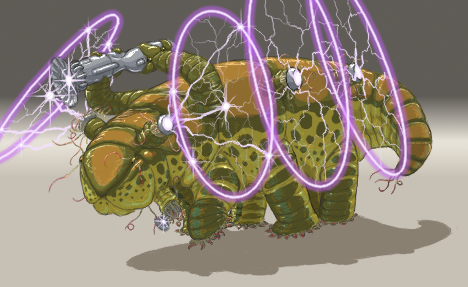
Starting AttributesSub-AttributesAbilitiesSkills |
| Strength: +10
| Mass: 3500 kg
|
Unarmed Penetration: 2d6, -2 RS
Unarmed Wound Score: +6
Unarmed Control: 2d6, +11 RS
Penetration Limit: 2d6, +5 RS
| Large Wound Limit: +11 | Wound Score Limit: +14¼ |
Injury Susceptibility: -9
| Action Score: -1 | Action Points: 4 |
| Stamina: 15 | Perseverence: 40 |
| Base Move: 7 m/turn | Maneuver: 30 m/turn² |
Top Ground Speed: 30 m/turn, 25 km/h
Top Swim Speed: 5 m/turn
Top Climb Speed: 5 m/turn
Long Jump: 5.5 m standing, 9 m running
High Jump: 4.7 m cleared, 12.7 m reach
Thresholds | | Penalty | Fatigue | Drain | Control | Encumbr. | | -1 | 4 | 10 | 200 | 1000 | | -2 | 5 | 15 | 300 | 1500 | | -3 | 7 | 20 | 400 | 2000 | | -4 | 10 | 30 | 500 | 3000 | | -5 | 15 | 40 | 700 | 4000 | | -6 | 20 | 50 | 1000 | 5000 | | -7 | | | 1500 | 7000 |
|
Attacks| Description | Type | Pen | Wound | AP | Sharp | Blunt | Def | Length | Grip | | Slap/Smash | Smash | 2d6, -2½ RS | +6 | +0 | +0 | +6 | +0 | 7 | +2 | | Bite | Slash | 2d6, +0 RS | +7 | +0 | +2 | +6 | +0 | 7 | +2 |
|
Squirm Grabber |
Grabbers are powerfully built mobiles with a rigid digging implement on their tail. They can rapidly dig backward to bury themselves or to excavate pits or tunnels. Grabbers have many tentacles that are stowed inside their mouths; they typically also carry equipment in their craw. The tentacles can be vomited out at need, with any equipment the grabber is using, to do their work.
Grabbers are feared for resting just under the ground and then bursting out in ambush. Grabbers may work with other morphotypes to excavate ditches, tunnels, or hiding spots for them to use.
The listed grabber is Size +3, about the size of a rhinoceros. Specimens have been observed ranging from Size +0 to Size +5 (mammoth-sized).
| | 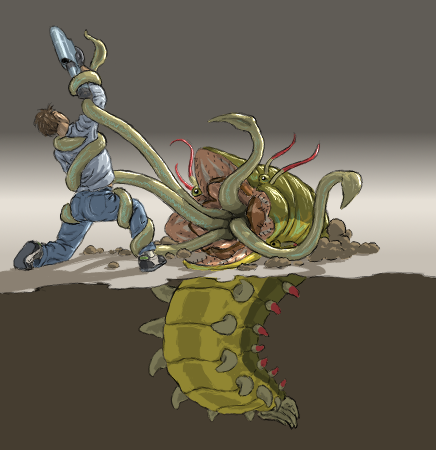
Starting AttributesSub-AttributesAbilities- Environmental Movement: Digger +7
- Environmental Movement: Swimmer +2
- Environmental Movement: Soft Ground, Slippery Ground, Uneven Ground, Tangled Ground +2
- Squirm Package
- Ground Fighter
Limitations- Physical Handicap: Poor Runner +4
Skills |
| Strength: +10
| Mass: 1500 kg
|
Unarmed Penetration: 2d6, -2 RS
Unarmed Wound Score: +5
Unarmed Control: 2d6, +8 RS
Penetration Limit: 2d6, +5 RS
| Large Wound Limit: +10 | Wound Score Limit: +13¼ |
Injury Susceptibility: -8
| Action Score: -¾ | Action Points: 4.2 |
| Stamina: 10 | Perseverence: 40 |
| Base Move: 6.5 m/turn | Maneuver: 60 m/turn² |
Top Ground Speed: 18 m/turn, 17 km/h
Top Swim Speed: 14 m/turn
Top Climb Speed: 6.5 m/turn
Long Jump: 6 m standing, 7.8 m running
High Jump: 4.5 m cleared, 10.5 m reach
Thresholds | | Penalty | Fatigue | Drain | Control | Encumbr. | | -1 | 3 | 10 | 70 | 400 | | -2 | 4 | 15 | 100 | 500 | | -3 | 5 | 20 | 150 | 700 | | -4 | 7 | 30 | 200 | 1000 | | -5 | 10 | 40 | 300 | 1500 | | -6 | 15 | 50 | 400 | 2000 | | -7 | | | 500 | 3000 |
|
Attacks| Description | Type | Pen | Wound | AP | Sharp | Blunt | Def | Length | Grip | | Slap/Smash | Smash | 2d6, -2½ RS | +5 | +0 | +0 | +5 | +0 | 5 | +2 | | Bite | Slash | 2d6, +0 RS | +6 | +0 | +2 | +5 | +0 | 5 | +2 |
|
Squirm Controller |
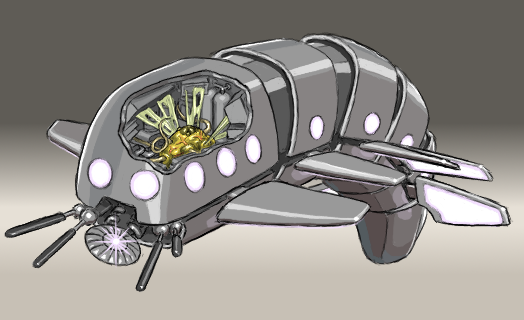 Controllers are mobiles designed to operate vehicles and other equipment.
They have blob-like bodies with a few tentacles, and thickets of fibrous cords attaching their bodies to their equipment control stations.
Outside of their vehicles or robots, they are poor combattants (although they can wield self-defense weapons if necessary).
Controllers are mobiles designed to operate vehicles and other equipment.
They have blob-like bodies with a few tentacles, and thickets of fibrous cords attaching their bodies to their equipment control stations.
Outside of their vehicles or robots, they are poor combattants (although they can wield self-defense weapons if necessary).
| | Starting Attributes- Brawn -1
- Coordination +2
- Smarts -2
- Size -1
Sub-AttributesAbilitiesLimitations- Physical Handicap: Cannot Jump
- Physical Handicap: Lame
- Physical Handicap: Poor Runner +8
- Physical Handicap: Walks with Hands +4
Skills- Drive +0
- Pilot +0
- Use Gear +2
|
| Unarmed Penetration: 2d6, -8½ RS
Unarmed Wound Score: +1
Unarmed Control: 2d6, -5 RS
Penetration Limit: 2d6, -1½ RS
| Large Wound Limit: +6 | Wound Score Limit: +9¼ |
Injury Susceptibility: +2½
| Action Score: -¼ | Action Points: 4.8 |
| Stamina: 5 | Perseverence: 40 |
| Base Move: 4.8 m/turn | Maneuver: 35 m/turn² |
Top Ground Speed: 3.8 m/turn, 4 km/h
Top Swim Speed: 1.4 m/turn
Top Climb Speed: 2.8 m/turn
Thresholds | | Penalty | Fatigue | Drain | Control | Encumbr. | | -1 | 1.5 | 10 | 1 | 5 | | -2 | 2 | 15 | 1.5 | 7 | | -3 | 3 | 20 | 2 | 10 | | -4 | 4 | 30 | 3 | 15 | | -5 | 5 | 40 | 4 | 20 | | -6 | 7 | 50 | 5 | 30 | | -7 | | | 7 | 40 |
|
Attacks| Description | Type | Pen | Wound | AP | Sharp | Blunt | Def | Length | Grip | | Slap/Smash | Smash | 2d6, -9 RS | +1 | +0 | +0 | +1 | +0 | 1.5 | +2 | | Bite | Slash | 2d6, -6½ RS | +2 | +0 | +2 | +1 | +0 | 1.5 | +2 |
|
Squirm Officer |
A typical mobile isn't very bright. Blights will make cleverer mobiles to command and coordinate squads of other mobiles.
Their officer's bonus to Smarts offsets the penalty to Smarts from the basic mobile package.
| | Starting AttributesAbilitiesSocial Standing |
Squirm Commando |
The more resources a blight puts into its mobiles, the more capable they are. This is an example of an elite mobile, designed for operating independently or in small groups for special ops or high strategic value missions.
This example shows a commando wiggler, but the commando type modification can be applied to any squirm morphotype.
| | Starting Attributes- Brawn +2
- Vigor +1
- Coordination +1
- Smarts +2
- Awareness +1
AbilitiesSkills- Blow Up +2
- Evade +2
- Fight +2
- Grapple +2
- Recon +2
- Sneak +2
- Spot +2
- Shoot +2
|
| Unarmed Penetration: 2d6, -6 RS
Unarmed Wound Score: +2
Unarmed Control: 2d6, +0 RS
Penetration Limit: 2d6, +1 RS
| Large Wound Limit: +7 | Wound Score Limit: +10¼ |
Injury Susceptibility: -1
| Action Score: +½ | Action Points: 6 |
| Stamina: 15 | Perseverence: 40 |
| Base Move: 6 m/turn | Maneuver: 40 m/turn² |
Top Ground Speed: 12 m/turn, 17 km/h
Top Swim Speed: 6 m/turn
Top Climb Speed: 8 m/turn
Long Jump: 2.5 m standing, 3.5 m running
High Jump: 1.7 m cleared, 3.7 m reach
Thresholds | | Penalty | Fatigue | Drain | Control | Encumbr. | | -1 | 4 | 10 | 5 | 30 | | -2 | 5 | 15 | 7 | 40 | | -3 | 7 | 20 | 10 | 50 | | -4 | 10 | 30 | 15 | 70 | | -5 | 15 | 40 | 20 | 100 | | -6 | 20 | 50 | 30 | 150 | | -7 | | | 40 | 200 |
|
Attacks| Description | Type | Pen | Wound | AP | Sharp | Blunt | Def | Length | Grip | | Slap/Smash | Smash | 2d6, -6½ RS | +2 | +0 | +0 | +2 | +0 | 3 | +2 | | Bite | Slash | 2d6, -4 RS | +3 | +0 | +2 | +2 | +0 | 3 | +2 |
|
Squirm Brute |
Brutes are Squirm designed with massive musculature, possibly for using heavy weapons or possibly just for packing all the equipment that soldiers need.
This example shows a brute wiggler, but the runner morphotype can also be made a brute. Leviathan brutes only get an extra +2 to Brawn (for a total of +4), and grabbers are already brutes.
| | | Starting AttributesAbilities |
| Unarmed Penetration: 2d6, -5 RS
Unarmed Wound Score: +2
Unarmed Control: 2d6, +2 RS
Penetration Limit: 2d6, +2 RS
| Large Wound Limit: +7 | Wound Score Limit: +10¼ |
Injury Susceptibility: -2
| Action Score: +0 | Action Points: 5 |
| Stamina: 10 | Perseverence: 40 |
| Base Move: 5 m/turn | Maneuver: 100 m/turn² |
Top Ground Speed: 20 m/turn, 25 km/h
Top Swim Speed: 10 m/turn
Top Climb Speed: 15 m/turn
Long Jump: 4 m standing, 6 m running
High Jump: 2.5 m cleared, 4.5 m reach
Thresholds | | Penalty | Fatigue | Drain | Control | Encumbr. | | -1 | 3 | 10 | 10 | 50 | | -2 | 4 | 15 | 15 | 70 | | -3 | 5 | 20 | 20 | 100 | | -4 | 7 | 30 | 30 | 150 | | -5 | 10 | 40 | 40 | 200 | | -6 | 15 | 50 | 50 | 300 | | -7 | | | 70 | 400 |
|
Attacks| Description | Type | Pen | Wound | AP | Sharp | Blunt | Def | Length | Grip | | Slap/Smash | Smash | 2d6, -5½ RS | +2 | +0 | +0 | +2 | +0 | 3 | +2 | | Bite | Slash | 2d6, -3 RS | +3 | +0 | +2 | +2 | +0 | 3 | +2 |
|
Squirm Scout |
Scouts are sent ahead to gather intelligence on enemy targets before a main attack, and sometimes to designate targets for artillery or airstrikes, or for stealth assassinations.
This example shows a scout runner, but other morphotypes can also be made into scouts.
Not all will be of reduced Size.
| | Starting Attributes- Coordination +2
- Smarts +2
- Awareness +2
- Size -1
Abilities- Direction Sense
- Photographic Memory
- Squirm Morphology Type
Skills- Blow Up +0
- Hide and Search +0
- Live Off the Land +2
- Recon +2
- Sneak +2
- Spot +2
|
| Unarmed Penetration: 2d6, -8 RS
Unarmed Wound Score: +1
Unarmed Control: 2d6, -4 RS
Penetration Limit: 2d6, -1 RS
| Large Wound Limit: +6 | Wound Score Limit: +9¼ |
Injury Susceptibility: +2
| Action Score: +1¼ | Action Points: 7.5 |
| Stamina: 15 | Perseverence: 40 |
| Base Move: 4.8 m/turn | Maneuver: 35 m/turn² |
Top Ground Speed: 28 m/turn, 45 km/h
Top Swim Speed: 2.8 m/turn
Top Climb Speed: 2.8 m/turn
Long Jump: 2.2 m standing, 5.5 m running
High Jump: 1.4 m cleared, 2.8 m reach
Thresholds | | Penalty | Fatigue | Drain | Control | Encumbr. | | -1 | 4 | 10 | 1.5 | 7 | | -2 | 5 | 15 | 2 | 10 | | -3 | 7 | 20 | 3 | 15 | | -4 | 10 | 30 | 4 | 20 | | -5 | 15 | 40 | 5 | 30 | | -6 | 20 | 50 | 7 | 40 | | -7 | | | 10 | 50 |
|
Attacks| Description | Type | Pen | Wound | AP | Sharp | Blunt | Def | Length | Grip | | Slap/Smash | Smash | 2d6, -8½ RS | +1 | +0 | +0 | +1 | +0 | 1.5 | +2 | | Bite | Slash | 2d6, -6 RS | +2 | +0 | +2 | +1 | +0 | 1.5 | +2 |
|
Squirm Hit Location Chart
| Hit Location Chart | Nerves | Circulatory | Respiration
|
| 1d10
| Location
| Brain | Spine | Heart | Vessl | Airwy | Lung
| | 1 | Head / Tentacles | | 1 | | | | | | 2 | Front Body / Tentacles | | 1 | | | | | | 3 | Front Body / Mobility | | | | | | | | 4 | Mid Body | 1-2 | 3 | | | | | | 5 | Mid Body | 1 | 2 | | | | | | 6 | Mid Body / Mobility | | | | | | | | 7 | Rear Body | | 1 | | | | | | 8 | Rear Body / Mobility | | | | | | | | 9 | Tail / Mobility | | | | | | | | 10 | Tail | | 1 | | | | | Defaults:
0 DOS: 1d10
1 DOS: 1d8
2 DOS: 1d6
3 DOS: 1d4 + 2
4+ DOS: Location 4On morphotypes with legs, mobility hits are treated as leg hits.
Squirm Blight Patch |
Blights are not helpless. In addition to swarms of mobiles they have tending them, blights grow tentacles than can grab intruders, wield weapons, and use tools to fight off enemies when they are not grooming, cleaning, and maintaining the blight or performing mundane chores. This is a patch of tentacles that might be found growing in a one square meter patch of ground. A typical blight wil have many of these.
The tentacle patch is in constant communication with the rest of the blight, but in keeping with the distributed command structure common to Squirm, they have their own brain for local control of the tentacles in the center of the tentacle mass. If this can be taken out, the whole patch of tentacles loses coordination and just begins writhing around randomly. In this condition, they will reflexively grab anything they encounter but will generally be much less dangerous.
In game terms, hit location 5 is the central node; penetrating wounds have a 1-in-3 chance of striking the local brain, which causes damage like a brain hit and can knock the patch out. Everything else just hits a tentacle. For cognitive convenience, the referee can decide that the patch has 9 tentacles, and each separate hit location other than the central node (5) hits a specific one of these tentacles.
Penetrating wounds to an individual tentacle have a 1-in-6 chance of hitting the control ganglion at the base of the tentacle, causing damage like a spine hit that can take that tentacle out of commission. Otherwise, tentacles are injured the same way that arms are.
| | Starting AttributesSub-AttributesAbilities- Squirm Package
- Stretchy +1
Limitations- No Natural Weaponry: Cutting Teeth
- Physical Handicap: Immobile
|
| Unarmed Penetration: 2d6, -5 RS
Unarmed Wound Score: +3
Unarmed Control: 2d6, +2 RS
Penetration Limit: 2d6, +2 RS
| Large Wound Limit: +8 | Wound Score Limit: +11¼ |
Injury Susceptibility: -3
| Action Score: -¼ | Action Points: 4.8 |
| Stamina: 10 | Perseverence: 40 |
Thresholds | | Penalty | Fatigue | Drain | Control | Encumbr. | | -1 | 3 | 10 | 10 | 50 | | -2 | 4 | 15 | 15 | 70 | | -3 | 5 | 20 | 20 | 100 | | -4 | 7 | 30 | 30 | 150 | | -5 | 10 | 40 | 40 | 200 | | -6 | 15 | 50 | 50 | 300 | | -7 | | | 70 | 400 |
|
Attacks| Description | Type | Pen | Wound | AP | Sharp | Blunt | Def | Length | Grip | | Slap/Smash | Smash | 2d6, -5½ RS | +3 | +0 | +0 | +3 | +0 | 4 | +2 |
|
Squirm Blight Tentacle |
Rather than a patch of tentacles, this is a single giant tentacle. Otherwise it acts similarly to the tentacle patch. Penetrating wounds to its base (hit location 10) have a 1-in-3 chance of striking its local brain. Penetrating wounds to other hit locations have a 1-in-6 chance of hitting the central nerve cord. This causes damage like a spine hit and can paralyze that hit location and all hit locations above it.
| | Starting AttributesSub-AttributesAbilities- Squirm Package
- Stretchy +3
Limitations- No Natural Weaponry: Cutting Teeth
- Physical Handicap: Immobile
|
| Unarmed Penetration: 2d6, -5 RS
Unarmed Wound Score: +3
Unarmed Control: 2d6, +2 RS
Penetration Limit: 2d6, +2 RS
| Large Wound Limit: +8 | Wound Score Limit: +11¼ |
Injury Susceptibility: -3
| Action Score: -¼ | Action Points: 4.8 |
| Stamina: 10 | Perseverence: 40 |
Thresholds | | Penalty | Fatigue | Drain | Control | Encumbr. | | -1 | 3 | 10 | 10 | 50 | | -2 | 4 | 15 | 15 | 70 | | -3 | 5 | 20 | 20 | 100 | | -4 | 7 | 30 | 30 | 150 | | -5 | 10 | 40 | 40 | 200 | | -6 | 15 | 50 | 50 | 300 | | -7 | | | 70 | 400 |
|
Attacks| Description | Type | Pen | Wound | AP | Sharp | Blunt | Def | Length | Grip | | Slap/Smash | Smash | 2d6, -5½ RS | +3 | +0 | +0 | +3 | +0 | 7 | +2 |
|
Squirm Infection
Anyone infected with Squirm parasites suffers the following disease
- Dose: +0. Each failure on the Potency check increases the Dose by 1. Each success decreases the Dose by 2.
Fatigue gained on a failed Potency check is not actual Fatigue, but is just used for tracking Symptoms (the parasites have suppressed the immune system, allowing them to multiply without an immune response causing debility for the victim).
- Potency: 9. Treatment with a generic squirmicide will decrease the Potency to 7. Squirmicides targeted against this particular strain decrease the potency to 4.
- Delay: 1 diurnal (day).
- Period: 1 diurnal (day).
- Cycles: Unlimited, 2 consecutive Potency checks to end.
- Symptoms: At the second Fatigue increment, the victim gains a Personality Trait (chosen at the time the infectious parasites were created, but it can be "Obey and Support the Squirm"). The level of the Personality Trait increases by 1 for each additional Fatigue Increment. At the Mild Shock level, the victim no longer has free will or his own agency, he must obey the parasitic compulsion. The infection can "pause" at any time, allowing the victim to recover the disease-related Fatigue while keeping the level of mind control already established.
At higher levels of shock, the parasites are replacing the victim's body with their own. Once the victim dies, the remaining tissues of his body are kept alive by the Squirm parasites as they eat him from the inside, his muscles and tendons gradually becoming masses of wriggling worms.
- Healing: value of [7-Vigor] days.
Back to Vergeworlds Main Page
|







 Controllers are mobiles designed to operate vehicles and other equipment.
They have blob-like bodies with a few tentacles, and thickets of fibrous cords attaching their bodies to their equipment control stations.
Outside of their vehicles or robots, they are poor combattants (although they can wield self-defense weapons if necessary).
Controllers are mobiles designed to operate vehicles and other equipment.
They have blob-like bodies with a few tentacles, and thickets of fibrous cords attaching their bodies to their equipment control stations.
Outside of their vehicles or robots, they are poor combattants (although they can wield self-defense weapons if necessary).